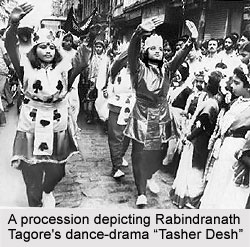 Rabindranath Tagore is considered as "sui generic" in Bengali theatre and dramatic Bengali literature. It is not possible to assign him a particular place chronologically. Nor is it easy to label his plays with useful tags, or define their relationship with the theatre. He wrote a large number of plays over a long period of time. Their variety in purpose, theme, structure, language and treatment is astonishing. Indeed, a number of them fall, at least by definition, beyond legitimate drama. His plays and his ideas of theatre developed along lines differing from the general direction of development of Bengali drama and theatre. They had little influence on other playwrights and his attitude to the theatre in Kolkata was cool, distant or, at best, ambivalent. He allowed many of his plays to be staged in the professional theatres but generally disapproved of their ways. Lastly, his own ideas changed over the years.
Rabindranath Tagore is considered as "sui generic" in Bengali theatre and dramatic Bengali literature. It is not possible to assign him a particular place chronologically. Nor is it easy to label his plays with useful tags, or define their relationship with the theatre. He wrote a large number of plays over a long period of time. Their variety in purpose, theme, structure, language and treatment is astonishing. Indeed, a number of them fall, at least by definition, beyond legitimate drama. His plays and his ideas of theatre developed along lines differing from the general direction of development of Bengali drama and theatre. They had little influence on other playwrights and his attitude to the theatre in Kolkata was cool, distant or, at best, ambivalent. He allowed many of his plays to be staged in the professional theatres but generally disapproved of their ways. Lastly, his own ideas changed over the years.
Like many other playwrights/dramatists he had an early fascination for the theatre and had acted before he wrote his first play at the age of twenty. The ancestral home of the Tagores at Jorasanko in north Kolkata had already been humming with artistic and literary activities when Rabindranath was born in 1861.
Rabindranath`s first stage appearance was in 1877 in a family production of a play by his elder brother, Jyotirindranath Tagore. His first `public` appearance as an actor was in his own Valmiki Pratibha, an episodic musical on the legendary author of the Ramayana.
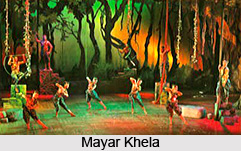 It was staged before an invited audience which included many eminent persons like Bankim Chandra Chatterjee, Haraprasad Sastri and Sir Gurudas Banerjee. From then on, when he was twenty-one, Tagore directed, produced and acted in many of the forty odd plays, long and short, that he wrote. He was seventy-five when he last appeared in Sarodatsab, staged in 1935 at Santiniketan, where he mostly stayed during the latter half of his life and where he staged many of his plays. For nearly five decades therefore he was interested in the theatre as dramatist, actor, composer and director.
It was staged before an invited audience which included many eminent persons like Bankim Chandra Chatterjee, Haraprasad Sastri and Sir Gurudas Banerjee. From then on, when he was twenty-one, Tagore directed, produced and acted in many of the forty odd plays, long and short, that he wrote. He was seventy-five when he last appeared in Sarodatsab, staged in 1935 at Santiniketan, where he mostly stayed during the latter half of his life and where he staged many of his plays. For nearly five decades therefore he was interested in the theatre as dramatist, actor, composer and director.
His first play Valmiki Pratibha was written in 1881. The story is expressed through a string of songs. A certain amount of dramatic conflict is there but it gets submerged in the music and the songs. Much later, when he had settled down at Santiniketan, he wrote a cycle of plays like Rituranga, Basanta, Phalguni and Sesh Barshan celebrating the seasons with an assemblage of songs loosely held together by the thinnest of dramatic threads. Some of his major dance dramas are - Chandalika, Tasher Desh, Chitrangada and Shyama- were written in the thirties when Tagore was past seventy. The dramatic element in them is considerable but the form which he evolved to expound the dramatic themes is a compound of dances, mime, music and choreography. They have their unique appeal but, like the musical and operatic plays, they have been the preserve of singing and dancing troupes and have had little influence on Bengali theatre.
Tagore`s reputation as a playwright had a mixed fare among the people. There were some that brought him near the professional theatre, while others pushed him away. The first full-fledged drama he wrote was Raja O Rani (1889) - five-act verse-play, it is full of melodramatic happenings, external conflict and romantic passion. It was popular in the commercial theatre of Kolkata.
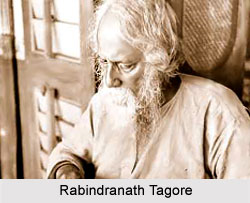 Raja O Rani was followed by Visarjan, another full-length verse-play. For two decades after Visarjan, there was no major plays written by Tagore- and this was the period when his poetry was undergoing a transformation in content and form. However, his play, Raja, appeared in 1910, was a different sort of play from the ones he had written before. Some indication of this is available in the two plays Sarodotsab and Prayaschitta he wrote before Raja. In both "externality" and "action" give way to philosophical "internality" and contemplative "inaction". It is mainly with Raja that kick-started the golden period of a cycle of plays. Raja helped to do away with many conventions of dramatic writing such as a rounded plot, narrative content, type characters etc.
Raja O Rani was followed by Visarjan, another full-length verse-play. For two decades after Visarjan, there was no major plays written by Tagore- and this was the period when his poetry was undergoing a transformation in content and form. However, his play, Raja, appeared in 1910, was a different sort of play from the ones he had written before. Some indication of this is available in the two plays Sarodotsab and Prayaschitta he wrote before Raja. In both "externality" and "action" give way to philosophical "internality" and contemplative "inaction". It is mainly with Raja that kick-started the golden period of a cycle of plays. Raja helped to do away with many conventions of dramatic writing such as a rounded plot, narrative content, type characters etc.
The two plays Tagore wrote after Raja were Achalayatan and Dakghar, both written in 1912. The first carried a lighter philosophical burden than Raja and is more dramatic in its portrayal of conflict. The second play, Dakghar, is the most widely known of Tagore`s plays, outside Bengal at any rate. It was written at the time when Tagore was writing Gitanjali and Gitali which won him the Nobel Prize for literature in 1913. Simple to the point of starkness in its structure and diction, Dakghar has the power and poignancy of symbolist drama at its best.
The cycle of symbolist plays reached its culmination in Raktakarabi in 1924. More complex in design than the other plays, it has a richness of imagery and texture unattained before. A few years earlier he had written another play in a similar vein- Muktadhara. Both Muktadhara and Raktakarabi are a condemnation of a civilisation dominated by these evils.
Tagore himself, with his enormous talent as an actor and his long experience of producing plays, was chary of staging them. To the theatregoer, therefore, Tagore came to be known as a dramatist not through the major plays he wrote but through an overblown melodrama, Raja O Rani, and two comedies Chirakumar Sabha and Sesh Raksha. The last two were quite popular and staged in different theatres in the late twenties and early thirties. They are slight comedies of error shakily standing on the feeble foundation of mistaken identity.
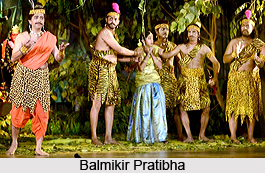
Tagore wrote plays intermittently over fifty years. As noted before, many of them can hardly be called by that name. He was also in the habit of revising and re-writing his plays and turning his novels and stories into plays.
Tagore`s ideas on the theatre crystallised after a gradual process of re-thinking. It is ironical that they were rejected by the Bengali theatre when they, so to speak, became more Bengali. After writing plays on western models Tagore changed to forms that were closer to Bengali folk forms. His plays were, of course, vastly superior to the work of the jatra play wrights but the formal imagination was consanguineous. Bengali theatre in its conscious striving to emulate English theatre had denied itself that imagination while adopting, unconsciously or otherwise, many of its debased features. A further irony was that the two principal architects of Bengali theatre, Girish Chandra Ghosh and Sisir Kumar Bhaduri, realised the dilemma and talked of the necessity of drawing upon the vital sap of folk forms.
By the time Dakghar was produced in 1917 at Vichitra Hall, an annexe of the Jorasanko House, before an audience which included, among others, Mahatma Gandhi, Bal Gangadhar Tilak, Pandit Malaviya and Mrs. Annie Besant, the change was noticeable, although Tagore had not done away with sets altogether.
Tagore`s views, quoted at some length, would seem to suggest that he had foreseen some of the dead ends and the dilemma of a bastardised theatre. In his own way he created his dramatic and theatrical oeuvres, and tried to indicate the way in which a genuine
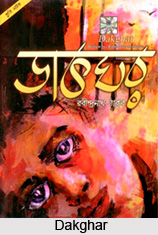 Indian theatre could come into being; a theatre which belonged to the soil and was true to its native genius, which sustained itself on plays inspired by Indian ideas of synthesis rather than conflict, on internality rather than external actions and which drew upon traditional sources to express universal truths. But then the Bengali theatre was a product of a set of socio-economic and cultural circumstances arising from certain historical situations. Tagore pleaded for small, intimate theatres which, as he put it, ``should aim to provide a meeting place for only the discerning and the cultivated." But possibly he did not see that such theatres gain significance only when there pre-exists a theatre with a wide popular base. It is doubtful if, given the conditions, such a theatre could have come into existence except in the way it did. As it happened, the rejuvenation of Bengali theatre in the fifties was in fact brought about by the little theatres Tagore talked of. The views of many who formed them were in some respects similar to Tagore`s. But any firm or generalised inference about Tagore`s direct influence on the New Drama movement will not bear scrutiny. At the most it can be said that some of the thrust of Bengali minority theatre`s new directions in the post-war and post-independence periods was derived from Tagore`s ideas and exhortations
Indian theatre could come into being; a theatre which belonged to the soil and was true to its native genius, which sustained itself on plays inspired by Indian ideas of synthesis rather than conflict, on internality rather than external actions and which drew upon traditional sources to express universal truths. But then the Bengali theatre was a product of a set of socio-economic and cultural circumstances arising from certain historical situations. Tagore pleaded for small, intimate theatres which, as he put it, ``should aim to provide a meeting place for only the discerning and the cultivated." But possibly he did not see that such theatres gain significance only when there pre-exists a theatre with a wide popular base. It is doubtful if, given the conditions, such a theatre could have come into existence except in the way it did. As it happened, the rejuvenation of Bengali theatre in the fifties was in fact brought about by the little theatres Tagore talked of. The views of many who formed them were in some respects similar to Tagore`s. But any firm or generalised inference about Tagore`s direct influence on the New Drama movement will not bear scrutiny. At the most it can be said that some of the thrust of Bengali minority theatre`s new directions in the post-war and post-independence periods was derived from Tagore`s ideas and exhortations













